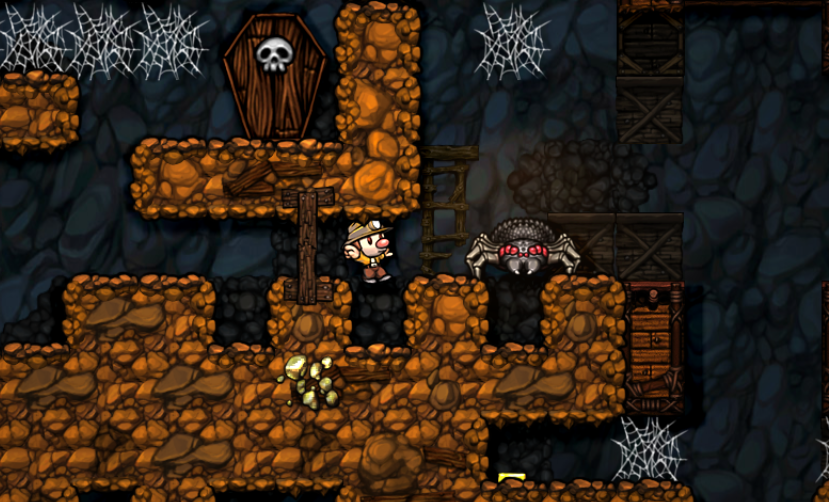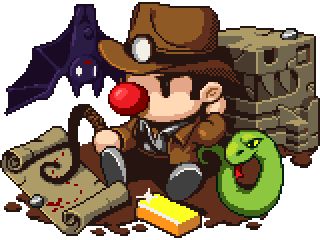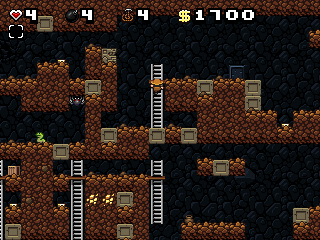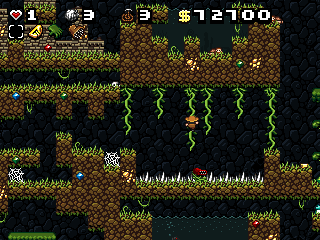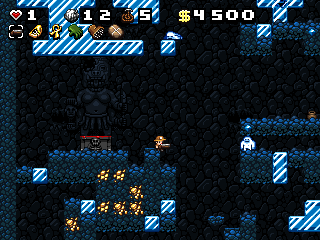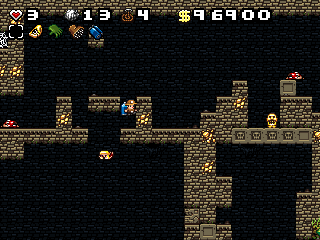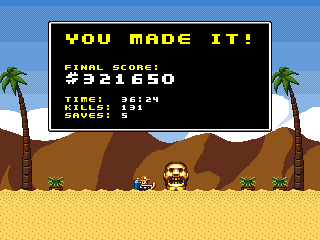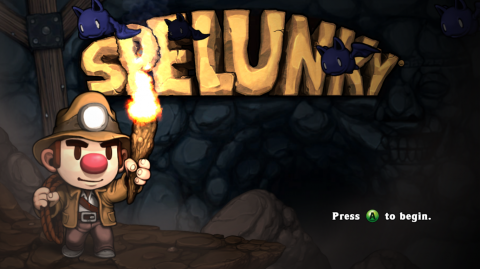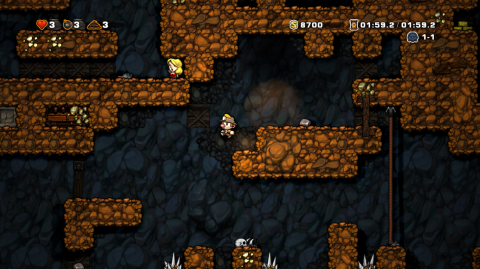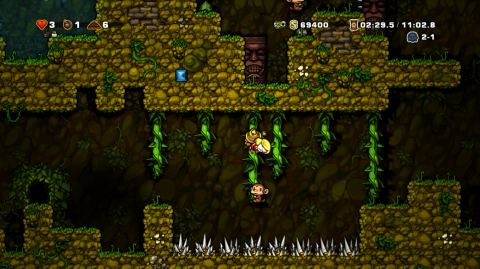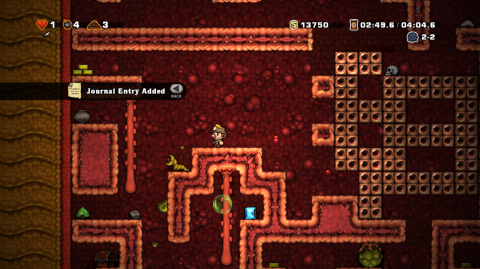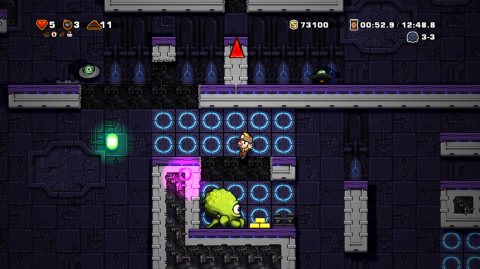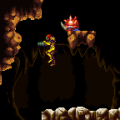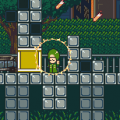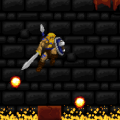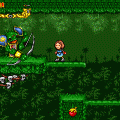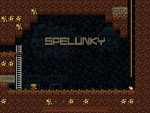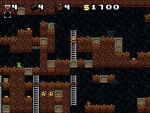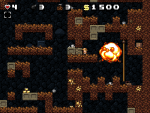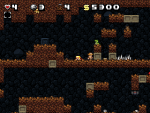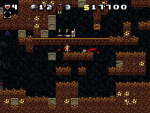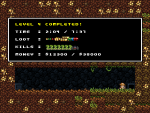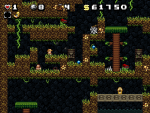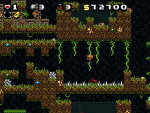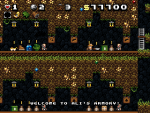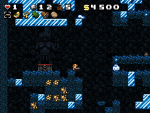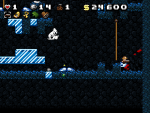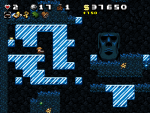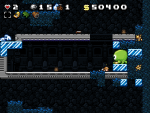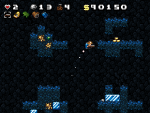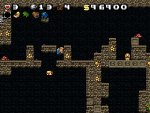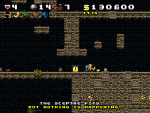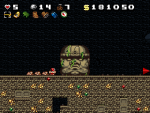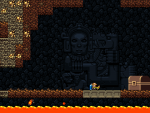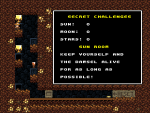Procedural generation is an interesting design avenue. Enabling what can be considered a unique experience every time one plays a game, replayability is often a large appeal. First recognized in 1980 with Michael Toy and Glenn Wichman’s Rogue, the practice has largely been used in conjunction with more turn-based affairs and rarely deviating from this practice with one of the more notable exceptions being Blizzard’s Diablo. Then in December of 2008, famed indie developer Derek Yu brought to the public consciousness the realization that procedural generation wasn’t strictly for the likes of slower-paced and methodical games when Mossmouth LLC. released the first public build of Spelunky.
Taking a little of this and a little of that from the Rogue-like formula and Broderbund/Irem’s legendary cave crawling kusoge, known as the Mascot of Bargin Bins, Spelunker; Spelunky is a 2D platform roguelike that is brutally unforgiving. Replayability is the name of the game, because death comes very quickly, and like most games of the roguelike tradition, dying causes the player to have to start all over again. The average game of Spelunky lasts somewhere between 10-15 minutes, and that’s if one is being careful. As such while one has to begin anew, the player doesn’t really lose -that- much compared to more turn-based predecessors which could cause several says of effort to be rendered moot by Yet Another Stupid Death.
Rendered in a pixel art style that is somewhat evocative of DOS shareware, Spelunky bears a simple to design but easy to identify appearance. A wise decision since being aware of one’s surroundings at all times is crucial. Joining the simple but effective visual style is the soundtrack, Joint composed by George Buzinkai and Jonathan Perry. While only 8 tracks long, each is memorable in its own way.
Taking control of a totally-not-cartoon-Indiana-Jones-esque delver of ancient mysteries and dangers, the player finds that their best means of survival is not to be found in the short jumps or La-Mulana inspired bull-whipping available to them. Those and the nominal supply of ropes and bombs while useful, pale in comparison to the knowledge and experience of how to engage a situation that only comes from repeated failures of survival. So saying, to ignore the options available are the fast track to another demise. As such, mastery of the particulars of movement, supply management and fight-or-flight are mandatory for success in Spelunky. So get used to failure.
But what is the goal? To risk life and limb in a cave of danger and despair, there must be a sufficient motive, right? Well, that right there is the simplest answer one will find in the whole game. Good old-fashioned greed. Within the caves are masses of gold, gems and other assorted treasures to line your pockets and increase your score. Wealth can be found lying about, in pots, chests and even the walls themselves. Most valuable of all however are the idols crafted by an unknown ancient peoples. So valuable in fact that attempting to claim them brings about their own dangers as like any good raider of the lost whatever, picking them up trigger traps that result in such classics as a giant rolling boulder and a quick descent to perforation.
It’s not all doom and gloom, however. In addition to the dangers and treasures, there are many things that may be chanced upon to make life a little easier and maybe just a little longer. In addition to extra supplies, there’s equipment to enhance or modify your basic abilities. The simple if bizarrely present parachute which can slow a single fall that’s just a bit too far. A glove that makes climbing any vertical surface possible. The compass that points unerringly towards the exit. These and more can be found by the fortuitous adventurer in crates strewn about the underground or in the very walls themselves. If however one is willing to part with their gains of avarice, there exists a league of merchants within the underground that will gladly provide goods in exchange for large sums of treasure. Some even run dice houses where one can try their luck in the hopes of beating the house for cash and prizes.
Help is a rare thing to be found underground. While the merchants will gladly provide it, they’ll only do so if their palms are sufficiently greased. If one tries to take their goods without fulfilling their demands, the wrath of the entire league will befall the hapless adventurer, pursuing them into the depths with only the desire for violent vengeance. However, they are not the only ones to be found underground. Within the depths are damsels who can only call for help or run away recklessly if threatened by the dangers of the caves. Should help be granted by carrying them to the exit their reward is a kiss. A humble gesture, but one that restores an adventurer’s ability to carry on as one of the few ways to increase one’s health pool.
The underground itself has many faces. What begins as a fairly mundane crawl through what seem to be hastily abandoned mines will lead to subterranean jungles with carnivorous plants and more than one outbreak of the living dead. From there one will find frozen caverns, the natural habitat of the elusive yeti. Care should be taken however as on its home turf, the yeti is not the one who does not want to be found. Should one survive the slippery sheets of ice, white-furred might, and the occasional close encounter of the first kind then one will be one step away from success. Deep within the bowels of the underground are ancient temples, still inhabited and in full use by those who don’t take kindly to trespassers. Beyond the temple is the goal of the adventure: The Ulmec and its treasure.
As with many roguelikes, however, it’s more about the journey than the destination. Along the way the player will encounter: traps of many a pointed variety; ghosts; exploding frogs; alien overlords; giant spiders; cavemen; physics; alters to Kali; angry old men; darkness; fish; mummies; the city of gold and of course snakes. Each and every single one of these will inevitably result in death in some fashion of another, the question is how. The procedurally generated nature of the game ensures it.
Although technically you do start over when you die, the game does provide some measure of permanence in the form of the Tunnel Man, who will offer to dig shortcuts to the later stages of the game in exchange for your hard-earned gold. The highest scores of gold acquired, damsels saved and entities killed are tracked and even rewarded when achieving certain thresholds. so there are some concrete goals to reach.
Skip ahead four years to 2012 and a remastered version of Spelunky was announced and released for the Xbox Live Arcade with ports on other platforms to follow over the next two years. Many celebrated this not just for the game but for the fact that this was the first commercial release Yu had been involved in since the release of Aquaria in 2007. However, with a price tag come expectations and a free game made with Game Maker that was four years old would need to have some significant additions to make it worthwhile.
The remade version follows the same basics of the original version and is largely expanded upon. Many incidentals are included, such as a journal that includes a bestiary and lists of the various locations and items you’ll come across. There’s even a catalogue of what traps you’ve come across. For all of these, the game will also track how many times you’ve been killed by them. Another minor but noticeable difference is the inclusion of alternate characters to play as should the player locate wooden caskets throughout the underground and release those bound within. There’s no mechanical difference between the spelunker and a pirate, but one is a pirate and a cool looking one at that. The last minor pleasantry is related to the Damsel. In the original version the part was always played by a blonde woman in a red dress, in the remade version you have the option of this same woman, a blonde Chippendale, an ugly dog, or any of the three at random. The threshold rewards have been done away with however.
The four core locations of the underground back and meaner than ever, but there are new “secret” locales to visit that replace the normal location levels, such as the inside of a giant worm or trespassing into a haunted castle. Not to be left out by these, the black market and city of gold are also still present. In addition, in the event that a difficult string of conditions are met, there is a hidden fifth location with its own set of four levels that are fully capable of killing you in new and horrifying ways.
This is not to say that the old guard have been forgotten either. Each location now has new enemies and hazards to complicate things. New to the mines, for example, are new varieties of snake and spider in addition to scorpions. There are also now highly unstable powder boxes strewn about that will detonate at the slightest provocation. The jungle now has bees. There also exist snails that spit toxic bubbles that slowly drift upward as well as boomerang-toting tribals. The frozen caves have been peppered by landmines, tanks and automated defenses, and this is all just the start.
The visuals have once again been handled primarily by Derek Yu with assistance by Andy Hull. The remade version has done away with the pixel art and instead embraced its cartoony style and has opted for an inked cell look for characters at a higher resolution with more modern overall look. The music has been handled entirely by Eirik Suhrke, who composed the 58 piece soundtrack. With the exception of a few percussion-centric tracks, jazz is the predominant genre of the game. Anyone who was fond of the original’s music, however, will find that none of the old tracks exist, even as remixes. However, quantity does not equate to quality and most of the music is rather ill-fitting and unimpressive.
The path to riches is more lethal than ever and that is the largest problem that the remake puts forth. If the player is coming from the original version, then the difference in physics will be a further complication. Many enemies are faster, recover from being stunned more quickly and are more aggressive on the whole. The level generations are much more hazardous and draining to one’s supply of resources. Projectile traps fire their payload at lightning velocity which makes old Spelunky bait-and-hide strategies inadvisable. The new UI even gets in on the act, with the score display having a large banner that obstructs a good portion of the upper screen corners leaving one ripe pickings for an opportunistic dropping spider. Thankfully, this was patched for the Windows and Sony versions to make it less obtrusive, though the Xbox 360 version was never fixed. The remade version offers local multiplayer, leaving those desiring online co-op needing to utilize third party programs.
If it’s not apparent by now, Spelunky is very particular about how everything works and how everything moves, the HD release especially. If one invests the time to become proficient at it, then the structure of the game’s design begins to fall into place. So saying, It’s almost impossible to truly “master” Spelunky, but with perseverance, one can most certainly improve and get better at it and as one’s competence improves, generally so does the experience, as a game that constantly presents challenges and adhere to the roguelike’s goal of being a difference experience each time. But one must become that skilled before the game becomes even remotely gratifying, and that can take hours upon hours of dying frustrating deaths before one even catches a glimpse of that point. It’s also a game that where having the goal be ‘victory’ does not play to one’s favor as that’s not really the game’s intention, and will probably result more in annoyance than anything. The only real goal beyond a point is the player’s own self-improvement in an unforgiving and hostile environment.
The remade Spelunky was a commercial and financial success. Its popularity has inspired numerous other games with roguelike elements, including Rogue Legacy and Dead Cells (inspired by Castlevania: Symphony of the Night), Nuclear Throne and Enter the Gungeon (both twin stick shooters), Crypt of the Necrodancer (rhythm and dungeon crawlers), and Flinthook, and numerous, numerous others. None of these make Spelunky worse, of course, but it does have a slightly more difficult time of standing out amongst the crowd, basically being the first of this particular iteration of the subgenre. Still, since there’s no reliance on grinding and everything placed on personal skill and situational luck, it’s still a product of it’s own merit. The lack of any real progression mechanics outside of level skipping is both the game’s biggest strength and its greatest weakness. For the many who will find Spelunky‘s frustrating charm elusive, there are many other types of games that might click more firmly.
